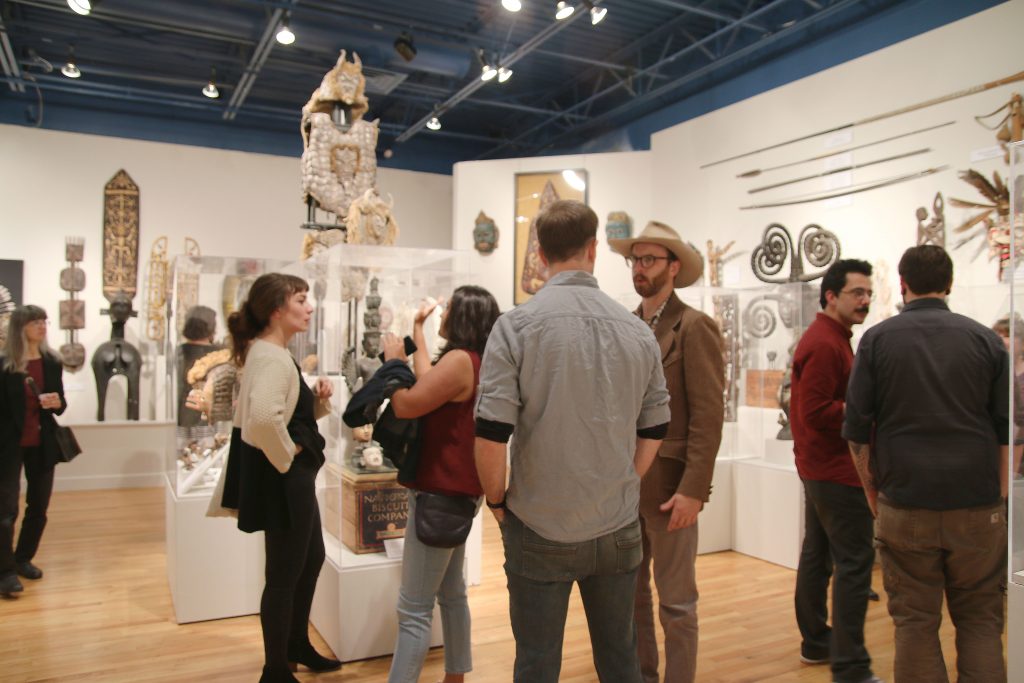
The Roberson Museum and Science Center held a reception on Friday for the opening of its newest exhibit, “A Theatre of Things: Conjuring the World on the Westside.” The exhibit displays cultural art pieces from the personal collection of Don Boros, professor emeritus of theatre at Binghamton University. A world traveler, Boros has lived among the indigenous peoples of several different countries. The vast array of objects in his collection reflects the diversity of his experiences abroad.
One of the highlights of Boros’ collection is a pair of masks given to him by an Indian dancer in 1976. Boros has been traveling for most of his life, but he didn’t start purposely seeking out art and artifacts from the places he visited until his first trip to Africa in 1984. Since then, he has collected a variety of cultural art pieces, mostly from Asia, the Pacific Rim and South America. His multicultural miscellany includes bamboo carvings from China, giant masks from Burkina Faso and water puppets from Vietnam. The pieces on display at the Roberson Museum and Science Center were all chosen from Boros’ collection by museum staff and curators.
The exhibit is meant to simulate the experience of walking through Boros’ home. The entrance, for example, is designed to look like the foyer of his house. In one corner of the exhibit, there is even a model of Boros’ desk, surrounded by vintage theatre posters and complete with an inkwell, a bookshelf and a photo album.
The exhibit also features a series of interviews with Boros, which were filmed and displayed on a screen. Visitors can also find anecdotes and quotes from Boros written on the objects’ labels.
Boros first began traveling the globe because he was “interested in the genesis of things,” more specifically, the genesis of theatre.
He has had a few brushes with danger during his travels, including a death sentence (which wasn’t fulfilled) and a bite from a rabid dog. In New Guinea, he met five Australian Rotarians who were there for a service project. A few days later, he learned that they had all been murdered.
“These Rotarians were there for altruistic reasons — to build schools, to build churches — and they were killed,” Boros said. “You just never know.”
After living in New Guinea for a month, Boros traveled to the Golden Triangle in Thailand, where he noticed that the ritual ceremonies were very similar to those he had seen in New Guinea. When he traveled to the Amazon basin, and then to the Western India, he began to see clear patterns in the way ritual ceremonies were conducted, affirming his belief in an innate theatrical instinct.
While some were bought at auctions, almost all of the pieces Boros owns were given to him in person and most have a deep sentimental value. The piece he feels most attached to came from the western half of New Guinea. In his travels, he has come across many maternity statues, but he’s only seen one statue depicting fatherhood: a figure of a man holding his dead child.
“The love I saw in this piece really knocked me out,” Boros said.
Among Boros’ collection of spears and weapons is a blowgun from Western Brazil. In his overview of the exhibit, Boros solemnly told audiences that the blowgun came from a tribe of people who no longer exist. It is evident that he sees his collection as a means of bringing global issues to light and preserving cultural histories that may otherwise go unremembered.
“I am a messenger, through that work, for people who don’t want their cultures and histories to die,” he said. “I love these people, and I have sincerely accepted the responsibility of passing information about them on.”


